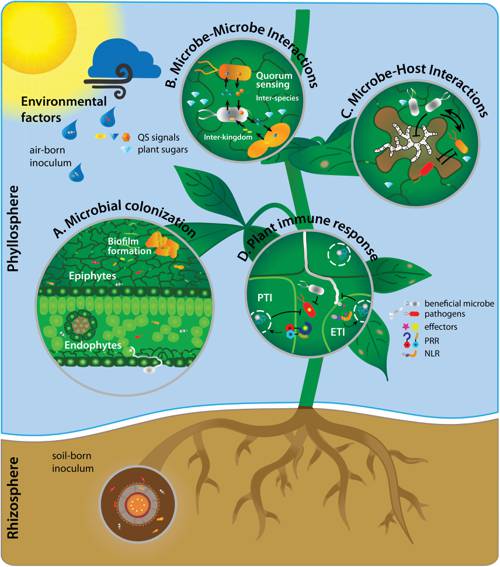
FAQ About Indoor Plant Growth-Supportive Microorganisms

What are growth-supportive microorganisms for indoor plants?
Growth-supportive microorganisms for indoor plants include beneficial bacteria, fungi, and other microbes that help plants thrive. These microorganisms can enhance nutrient uptake, assist in breaking down organic matter, and protect the plant roots from pathogens. Some common examples include mycorrhizal fungi, which form symbiotic relationships with plant roots, and nitrogen-fixing bacteria, which convert atmospheric nitrogen into a form plants can use.

How do mycorrhizal fungi benefit indoor plants?
Mycorrhizal fungi form a symbiotic relationship with plant roots, extending far into the soil. These fungi increase the surface area for water and nutrient absorption, particularly phosphorus, and help plants access nutrients that might otherwise be unavailable. The plant, in turn, supplies the fungi with carbohydrates as a form of food. This relationship can increase plant growth, improve drought resistance, and enhance overall plant health.

Can microorganisms help with disease prevention in indoor plants?
Yes, certain microorganisms can help prevent diseases in indoor plants. Beneficial microbes can outcompete pathogenic bacteria and fungi, reducing their ability to infect the plant. They can also trigger the plant's own immune responses, making them more resistant to infections. Some beneficial microbes produce antibiotics or substances that inhibit the growth of harmful organisms.

What is the role of nitrogen-fixing bacteria in indoor plant growth?
Nitrogen-fixing bacteria, such as those from the genus Rhizobium, convert atmospheric nitrogen into ammonia, a form that plants can uptake and use. This is particularly beneficial for plants grown in nitrogen-poor soils. While these bacteria are commonly associated with legumes in outdoor systems, inoculating indoor plants with these bacteria can also enhance nitrogen availability and promote plant growth.

How can beneficial microorganisms be introduced to indoor plants?
Beneficial microorganisms can be introduced to indoor plants through various methods. One common approach is using microbial inoculants or biofertilizers, which contain live beneficial microbes. These can be applied directly to the soil or mixed with water and applied as a foliar spray. Compost teas, which are rich in beneficial microorganisms, can also be added to the soil or sprayed onto plant leaves.

Are there commercial products available to add microorganisms to indoor plants?
Yes, there are numerous commercial products available that provide beneficial microorganisms for indoor plants. These include mycorrhizal fungi inoculants, bacterial inoculants, and comprehensive biofertilizer blends containing a mix of beneficial bacteria and fungi. When purchasing these products, it's important to choose those specifically labeled for indoor or potted plants to ensure compatibility and effectiveness.

What types of indoor plants benefit most from microorganisms?
Most indoor plants can benefit from the addition of beneficial microorganisms, but particularly those with strong root systems or those grown in less-than-ideal conditions. Plants that are heavy feeders, like tomatoes or houseplants such as pothos and peace lilies, may show more significant growth and health improvements when supported by microbial partners.

How often should microorganisms be applied to indoor plants?
The frequency of applying beneficial microorganisms depends on the specific product instructions and the particular needs of the plant. Generally, inoculants are applied at planting or repotting, and periodically throughout the growing season. Some products may suggest monthly applications, while others might be less frequent. It's important to follow product guidelines to avoid over-application and ensure optimal benefits.

Can beneficial microorganisms improve plant nutrient uptake?
Yes, beneficial microorganisms can significantly improve plant nutrient uptake. They do this by breaking down complex organic materials into simpler compounds that plants can easily absorb, particularly for nutrients like phosphorus and nitrogen. Fungi like mycorrhizae increase the plant's root absorptive capacity, while certain bacteria transform insoluble nutrients into forms that the plant can utilize.

Do beneficial microorganisms require special conditions to survive indoors?
Beneficial microorganisms generally thrive in conditions similar to those preferred by plants: adequate moisture, organic matter in the soil, and balanced pH levels. It's essential to avoid over-fertilizing or using fungicides and pesticides, which can harm the beneficial microbes. Ensuring a healthy growing environment will help sustain these microorganisms and benefit the plants.

Are there any drawbacks to using microorganisms with indoor plants?
While the benefits of using microorganisms with indoor plants are significant, there can be some drawbacks. For one, maintaining balanced soil ecosystems can sometimes be challenging indoors due to lack of natural processes like those found outdoors. Additionally, certain commercial products might not contain viable microbes if not stored properly. Monitoring plant and soil health is key to maximizing benefits while minimizing any potential drawbacks.

Can indoor plants thrive without beneficial microorganisms?
Indoor plants can grow without beneficial microorganisms, but these microbes often enhance plant health and growth rates. In nature, plants typically interact with a community of beneficial microbes that assist in nutrient absorption and disease prevention. Without these interactions, indoor plants may not reach their full potential and might require more frequent fertilization.

How do beneficial microorganisms affect the soil of indoor plants?
Beneficial microorganisms can improve the overall health of the soil in which indoor plants grow. They help decompose organic matter, improving soil structure and increasing the availability of nutrients. This microbial activity contributes to a more fertile and aerated planting medium, supporting root growth and plant vigor.

What is compost tea and how does it benefit indoor plants?
Compost tea is a liquid extract made by steeping compost in water. It contains a multitude of beneficial microorganisms and nutrients, which can be applied to indoor plants to enhance soil health and boost plant growth. Compost tea can be applied to the soil or used as a foliar spray to suppress diseases, improve nutrient uptake, and stimulate beneficial microbial activity around plant roots.

Are mycorrhizal fungi the only fungi beneficial to indoor plants?
Mycorrhizal fungi are among the most well-known beneficial fungi, but other fungi can also support indoor plant health. For example, Trichoderma spp. are beneficial fungi known for their ability to parasitize harmful fungi and enhance plant disease resistance. These fungi contribute to a balanced microbial ecosystem, promoting healthy plant growth.

Is it possible to identify beneficial microorganisms in soil without a lab?
While it's difficult to identify specific microorganisms in soil without laboratory equipment, observing soil health can offer clues. Healthy soil is typically dark, crumbly, and rich in organic matter. A diverse plant ecosystem and the presence of earthworms can also indicate active beneficial microbial communities. However, precise identification usually requires professional analysis.

Do beneficial microorganisms work immediately on indoor plants?
The effects of beneficial microorganisms may not be immediate and can vary depending on the plant, microorganism type, and growing conditions. Some benefits, such as disease resistance, might appear relatively quickly, while others, like improved growth rates or nutrient uptake, may take several weeks or months to become noticeable.

How do plants and microorganisms communicate?
Plants and microorganisms communicate through chemical signaling. Plants release various organic compounds from their roots, known as root exudates, which can attract beneficial microorganisms. In return, microorganisms produce signals that promote plant growth and defend against pathogens. This complex communication network ensures mutual benefits in plant-microbe interactions.

Can indoor plants develop a dependence on beneficial microorganisms?
While beneficial microorganisms significantly enhance plant growth, it's unlikely that indoor plants will develop a strict dependence on them. However, the presence of these microbes often allows plants to thrive with less external input, such as fertilizers. Without these microorganisms, plants may require more regular care and nutrition to maintain similar growth rates.
